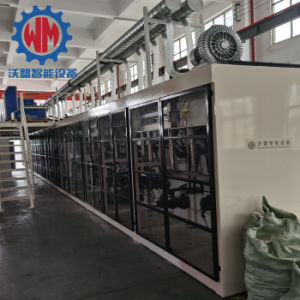Sanitary napkin making machines differ from machines used for other hygiene products, such as diapers or adult incontinence pads, due to several key factors:
- Design and Configuration: Sanitary napkin machines are specifically designed to cater to the unique structure and shape of sanitary napkins. They are configured to handle the specific layers (absorbent core, top sheet, back sheet) and shapes (with wings or without) required for sanitary napkin production.
- Material Handling and Sensitivity: The materials used in sanitary napkins, such as non-woven fabrics, absorbent core materials, and moisture-proof films, might differ from those used in other hygiene products. Sanitary napkin machines are engineered to handle these materials delicately to ensure product integrity and comfort.
- Absorbency and Thickness Control: Sanitary napkin machines are calibrated to control absorbency levels and thickness variations accurately. This precision is crucial for ensuring the napkins’ performance while maintaining comfort for the user.
- Product Configuration and Features: The configuration of sanitary napkins, including the shape, size, wings, and adhesive placement, differs significantly from other hygiene products. Machines for other products, such as diapers or incontinence pads, sanitary napkin making machine are tailored to accommodate their specific configurations.
- Consumer Comfort and Discreteness: Sanitary napkin machines focus on producing products designed for maximum comfort and discreteness during use. This aspect drives specific machine settings and processes tailored to ensure user comfort and convenience.
- Market Demand and Preferences: The market demands for sanitary napkins differ from other hygiene products. Sanitary napkin machines are aligned with specific market preferences for different absorbencies, sizes, and designs desired by consumers.
While there might be similarities in the machinery used for various hygiene products, the specific requirements, materials, configurations, and consumer preferences for sanitary napkins necessitate dedicated machines designed to cater to these unique aspects of production.
Can an sanitary napkin making machine handle different absorbency levels?
Yes, modern sanitary napkin making machines are often designed with the capability to handle different absorbency levels. The machines can adjust several parameters to cater to varying absorbency requirements:
- Absorbent Core Configuration: Machines can be adjusted to accommodate different compositions and thicknesses of absorbent cores. This adjustment allows for variations in absorbency levels, from light to heavy flow.
- Material Selection and Layering: The machines can handle different types of absorbent materials and configure the layering of these materials within the napkin to achieve desired absorbency levels.
- Dosing and Distribution Control: Precision dosing mechanisms control the amount and distribution of absorbent materials within the core, allowing for adjustments in absorbency levels across the napkin.
- Thickness and Density Control: Machines can regulate the thickness and density of the absorbent core, which directly influences the napkin’s absorbency capacity.
- Perforation or Channeling Techniques: Some machines incorporate perforation or channeling techniques within the absorbent core to enhance fluid distribution and increase absorbency without compromising comfort.
- Testing and Quality Control: Quality control mechanisms integrated into these machines ensure that the manufactured sanitary napkins meet the specified absorbency standards through rigorous testing during production.
These capabilities allow manufacturers using sanitary napkin making machines to produce a range of napkins with different absorbency levels, meeting the diverse needs of consumers for various flow intensities.
